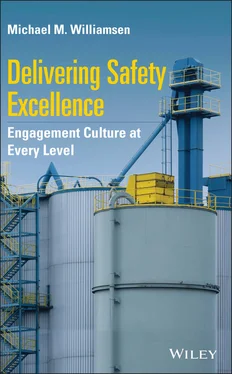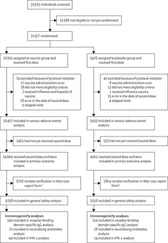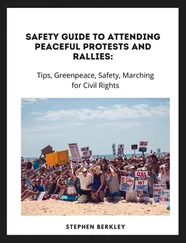1 Cover
2 Title Page Delivering Safety Excellence Engagement Culture at Every Level Michael M. Williamsen, PhD Cobden, IL, USA cultureoddysey.com
3 Copyright
4 Acknowledgements
5 Author Biography
6 List of Figures
7 Preface
8 Prologue Note
9 Introduction
10 Part I 1 The Funeral Notes 2 No Support for Safety 3 The Tyranny of the Urgent 4 No Pay for Safety Note 5 Weak Culture Miseries 6 Injury Plateau Limitations of Safety Observation Sampling Note 7 A Brief Safety History 8 Beyond Accident Reaction Note
11 Part II 9 Safety Culture Beginnings Notes 10 More Safety Culture 10.1 Background for Culture Improvement 10.2 Human Interaction Realities 11 Active Resistance 12 Zero Injuries 13 How Long? 13.1 POP Statement 13.2 Action Item Matrix (AIM) 13.3 Workers' Compensation Carrier Claim Processing Procedure 14 World‐Class Safety Note 15 Watch Out 15.1 Setting Priorities 15.2 Management Reluctance to Be Involved 15.3 Regulatory Audits 15.4 Team Inclusiveness 15.5 The Importance of Good Data and a Solid Improvement Process 15.6 The Need for a Challenging Time Line 15.7 Urgency Followed by Complacency 15.8 Series or Parallel Problem Attack Process 15.9 The Importance of Viable Metrics Note
12 Part III 16 Moving Forward to Safety Culture Excellence Note 17 The Critical Safety Steering Team 18 The RIW Process 18.1 Rapid Improvement Workshop Teams 18.2 Delivering a Better Safety Performance 19 Fundamentals That Are a Result of Developing a Culture of Safety Excellence Note 20 Communication and Recognition 20.1 Encouraging Positive Behavior Notes 21 Hazard Recognition Is Different than Hazard Control 21.1 The Common Threads 21.2 Overestimating Personal Capabilities 21.3 Complacency – Familiarity with the Task 21.4 Safety Warnings – the Severity of the Outcome 21.5 Voluntary Actions and Being in Control of Them 21.6 Personal Experience with an Outcome 21.7 Cost of Noncompliance 21.8 Overconfidence in the Equipment 21.9 Overconfidence in Protection and Rescue 21.10 Potential Profit and Gain from Action 21.11 Role Models Accepting Risk Note 22 The Trap of Complacency
13 Epilogue
14 A The History of the Continuous Excellence Performance (CEP)/Zero Incident Performance (ZIP) Process
15 B The Railroad Study by Petersen and Bailey Using Behavioral Techniques to Improve Safety Program Effectiveness B.1 MR Study of Safety Program EffectivenessB.2 Railroad I B.3 Railroad II B.4 Railroad III B.5 Railroad IV Appendix 1: Sample – Chart Used for Analysis on One of the Study Railroads Appendix 2: Sample – Chart Used for Analysis on One of the Study Railroads Appendix 3: Sample – Chart Used for Analysis on One of the Study Railroads Appendix 4: Sample – Chart Used for Analysis on One of the Study Railroads Appendix 5: Sample – Chart Used for Analysis on One of the Study Railroads Appendix 6: Total Response – 20 Categories – 4 Railroads Appendix 7: Comparison of Positive Responses by Category – 4 Railroads Appendix 8: Comparison of Training Results – 4 Railroads Appendix 9: Positive Recognition Training Outline Appendix 10: Assessment Questions Used by Supervisors Appendix 11: Analysis of Responses to Pilot Survey Questionnaires for Railroads I and II. Source: Based on American association of railroads
16 C The Charter Document C.1 Process and Objectives (Outcomes) C.2 Scope and Authority C.3 Roles and Responsibilities C.4 Team Member Representation C.5 Team Safety Department Representative C.6 Voting and Quorum C.7 Team Member Service C.8 Team Leader Service C.9 Selection of Team Leader C.10 Meeting Frequency C.11 Recordkeeping C.12 Communication C.13 Team Learning Plan C.14 Annual Review of POP Statement (Purpose Objective Process) and Team Charter C.15 Measurables C.16 Effective Team Norms C.17 Steering Team Member Training C.18 Continuous Improvement Team Management C.19 Continuous Improvement Topics
17 Index
18 End User License Agreement
1 Appendix BTable B.1 Twenty category summary of safety program differences.
1 Chapter 1 Figure 1.1 Work on the job site.
2 Chapter 2 Figure 2.1 Action item matrix.
3 Chapter 3 Figure 3.1 The ROI matrix.
4 Chapter 7 Figure 7.1 Heinrich accident pyramid. Figure 7.2 Enhanced accident pyramid.Figure 7.3 Safety management categories.Figure 7.4 Building a safety culture.
5 Chapter 8Figure 8.1 Accident reaction cycle.
6 Chapter 9Figure 9.1 Six criteria for safety excellence.
7 Chapter 10Figure 10.1 Six levels of safety.Figure 10.2 Results by category.
8 Chapter 11Figure 11.1 Four required business standards.Figure 11.2 The comfort zone concept with respect to operating within busine...Figure 11.3 The buffer zone concept with respect to operating within busines...Figure 11.4 Amount of flexibility for a teenager with respect to family stan...Figure 11.5 Safety regulations fit well inside safety culture standard limit...
9 Chapter 12Figure 12.1 Safety journey.
10 Chapter 13Figure 13.1 Recordable injury frequency chart.Figure 13.2 Purpose Outcomes Process.Figure 13.3 POP statement: CI inspection team.Figure 13.4 Action item matrix.Figure 13.5 Workers' compensation carrier claim processing procedure.Figure 13.6 AIM team tracking.Figure 13.7 The classic requirements for having a fire.Figure 13.8 Requirements for having a culture of operational excellence.
11 Chapter 14Figure 14.1 Accountability: World‐class vs. traditional.
12 Chapter 15Figure 15.1 Past to future recordable incident rate.Figure 15.2 Lagging indicators.
13 Chapter 16Figure 16.1 Why injuries happen.Figure 16.2 A process to achieve safety culture excellence.
14 Chapter 18Figure 18.1 Four Ws for forming a team.Figure 18.2 Rapid improvement workshop.Figure 18.3 Tools used by CI teams.
15 Chapter 19Figure 19.1 Accountability model.Figure 19.2 Accountability measurement model.
16 Chapter 20Figure 20.1 Safe behavior recognition.
17 Chapter 21Figure 21.1 Perception and tolerance model.
18 Chapter 22Figure 22.1 Lagging indicators.
19 Appendix BFigure B.1 Summary of injuries per million man‐hours worked in Industry show...Figure B.2 Differences in approaches to safety programming. In practice, mos...Figure B.3 Initial study group photo.Figure B.4 Discussion group on human behavioral factors.Figure B.5 Pilot survey questions discussion.Figure B.6 Minnesota graduate students.Figure B.7 The percentage of unsafe acts observed in the “baseline” period b...
1 Cover Page
2 Table of Contents
3 Begin Reading
1 iii
2 iv
3 xi
4 xii
5 xiii
6 xv
7 xvi
8 xvii
9 xix
10 xxi
11 xxii
12 xxiii
13 xxv
14 xxvi
15 xxvii
16 1
17 3
18 4
19 5
20 6
21 7
22 8
23 9
24 10
25 11
26 12
27 13
28 14
29 15
30 16
31 17
32 18
33 19
34 20
35 21
36 22
37 23
38 24
39 25
40 26
41 27
42 28
43 29
44 30
45 31
46 32
47 33
48 34
49 35
50 36
51 37
52 38
53 39
54 40
55 41
56 42
57 43
58 44
59 45
60 47
61 48
62 49
63 50
64 51
65 52
66 53
67 54
68 55
69 56
70 57
71 58
72 59
73 60
74 61
75 62
76 63
77 64
78 65
79 66
80 67
81 68
82 69
83 70
84 71
85 72
86 73
87 74
88 75
89 76
90 77
91 78
92 79
Читать дальше












